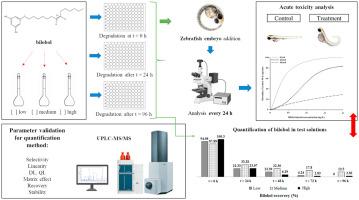Chemosphere ( IF 8.1 ) Pub Date : 2020-09-16 , DOI: 10.1016/j.chemosphere.2020.128323 Heidi Luise Schulte , João Paulo Barreto Sousa , Diego Sousa-Moura , Cesar Koppe Grisolia , Laila Salmen Espindola

|
Aedes aegypti is the main arbovirus vector transmitting chikungunya, Zika and dengue. The current vector control strategies are limited due to multiple insecticide resistance, deleterious impacts on the environment, and toxicity to non-target organisms. Bilobol, an alkylresorcinol isolated from the plant species Schinus terebinthifolia, demonstrated larvicidal activity against Aedes aegypti (LC50 7.67 mg/L in less than 24 h). To ensure that bilobol presents a viable alternative as an eco-friendly larvicide, this study aimed to explore the degradation process and acute toxicity of this alkylresorcinol in zebrafish, a non-target organism. A quantification method with validated parameters was developed and used to evaluate bilobol degradation in water over time. The Fish Embryo Toxicity (FET) test was applied to evaluate the acute toxicity of bilobol together with its degradation derivates. Results demonstrated that bilobol gradually degrades over time and almost completely disappears after 96 h, turning into small aliphatic chains which are less toxic than bilobol in its fundamental form. Therefore, it was possible to conclude that bilobol does not present significant toxicity to zebrafish embryos nor does it show signs of persistence in the environment. Additionally, bilobol can be found in high quantities not only in S. terebinthifolia, but also in cashew nut industry waste. Thus, bilobol constitutes an alternative environmentally friendly insecticide because it is not persistent, has indications of low toxicity to non-target organisms and presents a way to exploit massive quantities of material discarded by the food industry.
中文翻译:

胆甾醇,一种有前途的环保杀幼虫剂的降解评估和毒性概况
埃及伊蚊是传播基孔肯雅热,寨卡病毒和登革热的主要虫媒病毒载体。由于多种杀虫剂抗性,对环境的有害影响以及对非目标生物的毒性,当前的媒介物控制策略受到限制。从植物物种Schinus terebinthifolia分离出的一种烷基间苯二酚Bilobol具有抗埃及伊蚊的杀幼虫活性(LC 50在不到24小时的时间内达到7.67 mg / L)。为确保叶绿波醇作为一种环境友好的杀幼虫剂成为可行的替代品,本研究旨在探讨该烷基间苯二酚在斑马鱼(一种非目标生物)中的降解过程和急性毒性。开发了一种具有经过验证的参数的定量方法,并将其用于评估水中的双酚B随时间的降解。鱼胚胎毒性(FET)测试用于评估胆总酚及其降解衍生物的急性毒性。结果表明,随着时间的推移,山茱lo逐渐降解,并在96小时后几乎完全消失,变成小的脂肪链,其毒性比基本形式的山茱bol低。因此,可能得出的结论是,胆甾醇对斑马鱼的胚胎没有明显的毒性,在环境中也没有持久的迹象。此外,不仅在S. terebinthifolia,但在腰果行业中也浪费。因此,因为它不是持久性的,并且对非目标生物毒性低,并且提供了一种利用大量食品工业所丢弃的材料的方法,所以它是一种替代的环保杀虫剂。











































 京公网安备 11010802027423号
京公网安备 11010802027423号